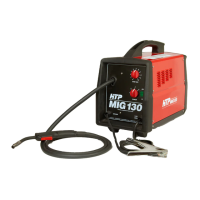6
• Do not wear a cracked or broken
helmet and replace any cracked or broken
filter lenses IMMEDIATELY.
• Do not allow the uninsulated portion
of the wire feed gun to touch the ground
clamp or grounded work to prevent an
arc flash from being created on contact.
• Provide bystanders with shields or hel-
mets fitted with a #10 shade filter lens.
• Wear protective clothing. The intense
light of the welding arc can burn the skin
in much the same way as the sun, even
through light-weight clothing. Wear dark
clothing of heavy material. The shirt worn
should be long sleeved and the collar
kept buttoned to protect chest and neck.
• Protect against REFLECTED ARC RAYS. Arc
rays can be reflected off shiny surfaces
such as a glossy painted surface, alu-
minum, stainless steel, and glass. It is pos-
sible for your eyes to be injured by reflect-
ed arc rays even when wearing a protec-
tive helmet or shield. If welding with a
reflective surface behind you, arc rays can
bounce off the surface, then off the filter
lens on the inside of your helmet or shield,
then into your eyes. If a reflective back-
ground exists in your welding area, either
remove it or cover it with something non-
flammable and non-reflective. Reflective
arc rays can also cause skin burn in addi-
tion to eye injury.
FIRE HAZARDS
WARNING
FIRE OR EXPLOSION CAN CAUSE DEATH,
INJURY, AND PROPERTY DAMAGE! To
reduce the risk of death, injury, or property
damage from fire or explosion, read, under-
stand, and follow the following safety instruc-
tions. In addition, make certain that anyone
else that uses this welding equipment, or is a
bystander in the welding area, understands
and follows these safety instructions as well.
REMEMBER! Arc welding by nature produces
sparks, hot spatter, molten metal drops, hot
slag, and hot metal parts that can start fires,
burn skin, and damage eyes.
• Do not wear gloves or other clothing that
contains oil, grease, or other flammable
substances.
• Do not wear flammable hair preparations.
• Do not weld in an area until it is checked
and cleared of combustible and/or flam-
mable materials. BE AWARE that sparks
and slag can fly 35 feet and can pass
through small cracks and openings. If
work and combustibles cannot be sepa-
rated by a minimum of 35 feet, protect
against ignition with suitable, snug-fit-
ting, fire resistant, covers or shields.
• Do not weld on walls until checking for
and removing combustibles touching the
other side of the walls.
• Do not weld, cut, or perform other such
work on used barrels, drums, tanks, or
other containers that had contained a
flammable or toxic substance. The tech-
niques for removing flammable substance
and vapors, to make a used container safe
for welding or cutting, are quite complex
and require special education and training.
• Do not strike an arc on a compressed gas
or air cylinder or other pressure vessel.
Doing so will create a brittle area that can
result in a violent rupture immediately or at
a later time as a result of rough handling.
• Do not weld or cut in an area where the
air may contain flammable dust (such as
grain dust), gas, or liquid vapors (such as
gasoline).
• Do not handle hot metal, such as the
work piece or electrode stubs, with bare
hands.
• Wear leather gloves, heavy long sleeve
shirt, cuffless trousers, high-topped shoes,
helmet, and cap. As necessary, use addi-
tional protective clothing such as leather
jacket or sleeves, fire resistant leggings, or
apron. Hot sparks or metal can lodge in
rolled up sleeves, trouser cuffs, or pockets.
Sleeves and collars should be kept but-
toned and pockets eliminated from the
shirt front.
• Have fire extinguisher equipment handy
for immediate use! A portable chemical
fire extinguisher, type ABC, is recom-
mended.
• Wear ear plugs when welding overhead to
prevent spatter or slag from falling into ear.
• Make sure welding area has a good, solid,
safe floor, preferably concrete or masonry,

